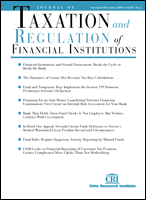S corporation Elections for Financial Institutions After the American Jobs Creation Act
Author: Richard A. Soukup.; John R. Ziegelbauer.
Source: Volume 18, Number 04, March/April 2005 , pp.31-36(6)

< previous article |next article > |return to table of contents
Abstract:
Over the last eight years that banks and thrifts have been able to convert to S corporation status, the number of banks and thrifts making the election has steadily increased each year. Today, over 24% of financial institutions are S corporations. As of March 31, 2004, a total of 2,137 banks and thrifts are S corporations. The S corporation election allows communitybased banks and thrifts to provide a higher after-tax rate of return to their shareholders, which makes remaining independent a more attractive alternative. Although a substantial number of banks have already made the conversion to S corporation status, there are many more that would like to. Banks that have thus far been unable to make the S corporation election often pointed to barriers that prevented them from making the election. Modifying ownership and eliminating ineligible classes of stock prior to the beginning of the first S corporation tax year have been major barriers to banks otherwise interested in making the election. The 2004 Tax Act1 cured some of these problems, as discussed in detail below, but a number remain. Changes made by the 2004 Tax Act generally make it easier for banks to make the S corporation election. The number of banks making the election is expected to increase in the coming years due to these changes. The enactment of these changes late in 2004 undoubtedly did not give some banks enough time to restructure in time to make the election for 2005. Accordingly, it would not be surprising if a surge in the number of banks making the S corporation election is spread out over two or more years. Consolidation in the financial institution industry continued at a significant pace in 2004. A number of the banks acquired during 2004 were probably S corporation banks just due to the sheer number of S corporation banks that existed at the beginning of the year. S corporation banks are attractive acquisition candidates as discussed in detail below due to some favorable tax rules that can be applied, especially after the bank has had S corporation status for more than ten years. A significant number of S corporation banks will soon be approaching this ten-year threshold. Once they have been an S corporation in excess of ten years they will be free then from any potential built-in gains tax liability, generally making them much more attractive acquisition candidates than comparable C corporation banks.Keywords:
Affiliations:
1: Grant Thornton; 2: Grant Thornton.